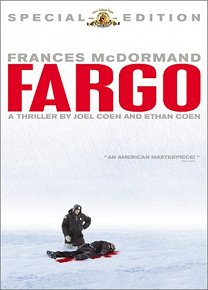
In my infinite wisdom, the movieI have chosen to research is Fargo, a murder drama that takes place in Fargo, North Dakota. It was wrtten and directed in 1996 by the Coen Brothers, Ethan and Joel, critically-acclaimed directors of Millers Crossing, Blood Simple and The Big Lebowski. "Blood Simple", the brothers' first movie which they both wrote and directed, debuted in 1984 and was met with a fair amount of critical acclaim, enabling the brothers to begin establishing a name for themselves. The Coen brothers are somewhat known for creating glacial pace in their movies, which can be seen easily in Blood Simple, Millers Crossing and Fargo, to name a few; these are films that all start off at a crawl and then pick up substantially. Fargo is no different. The plot kicks off with a car salesman, Jerry Lundegaard, who arranges to have his wife kidnapped by two thugs in order to get ransom money from his father in law. The deal goes wrong when the thugs, Carl Showalter and Gaear Grimsrud kill a police officer and two civilians on their way out of town. This is what alerts the local police, headed by Margie Gunderson (Frances McDormand) to their goings ons. Eventually, Carl shoots the senior Lundegaard and takes all the ransom money, only to be killed by his accomplice Gaear. By the time Margie catches up to them, Gaear is systematically shoving Showalter's body into a woodchipper. He is shot and, along with Jerry Lundegaared, apprehended. The movie ends with Margie returning home to her loving husband and ordinary life.
In terms of visuals, Fargo is very sincerely a Coen brothers movie. It is very visual, taking advantage of the cold North Dakota winters and showing broad expanses of frozen land. The interiors of the houses are impressive as well, always made to look homey and lived in, full of trinkets and junk. Color doesn't always play a huge part in Coen movies, and in this one the color is fairly muted due to the overbearing white of the snow. However, there are some scenes that take place in Carl and Gaear's car at night when the red light of a car's tail lights heighten the sick feeling of tension.
The thing I really love about this movie is the dialogue. Every character has a completely different and unique way of speaking, not so much in accent but in tone and word choice. You could probably tell which character was speaking in the script without names, the style is so specific to the character. Every conversation any characters have are carefully choreographed to be meaningful without being exhaustingly so; you get the sense that every moment of dialogue is important without feeling like you're having too much information forced upon you. Not everything can be about exposition without seeming too earnest, but in Fargo, moments of casual exchanges have been woven in throughout plot advancement, making the plot line fuller and easier to navigate. Plot development and tempo in Coen films typically follow a similar arc; the movies start of slowly, the scenes building in momentum until several scenes and exposition happen all at once. Fargo follows this same template, ending with another, smaller slow arc that wraps things up quietly. Miller's Crossing was like that as well, or at least I assume. I didn't make it all the way through that one, I had to take a breather from which I have yet to recover.
The scene I presented is actually very sparse. There are four different shots and angles total, three of which are close ups of Margie and Gaear. Usually the close up stays on Margie, who is the only character with lines in this particular scene, as she talks but when she says "There's more to life than a little money, you know" the camera holds on Gaear's expressionless face, further illustrating his lack of conscience and emotion. When the shot cuts back to Margie and she says "Don't you know that?" we see a little bit of what might seem like naievety but I think is really just Margie's firm belief that people are basically good. The fact that she is a police officer and still holds this belief makes her more of a heroic character, and in the scheme of what has unfolded in this movie, the fact that Margie can remain so morally clean (in belief, not necessarily in deed-she is, after all, a pregnant cop, making her an already "clean" and "good character), is remarkable. She remains unjaded, even after seeing a man go through a woodchipper. I think this also echos the mindset of the North Dakota town that the Coen bros' were trying to exemplify--the almost amnesiac attitude that allows them to live their small lives happily. That is not to say that these lives have less merit or are less worthy of note. Its something that police have to adopt, otherwise they are controlled by their jobs and having seen too much, I believe.
Its a short scene, so most scene transitions are action-to-action or even moment-to-moment, because there's not a whole heck of a lot of action taking place. However, I feel this is the peaking moment of intensity in the movie; others might feel it is the moment when Margie discovers Gaear and the woodchipper, and that moment is definitely the culmination of the main plot action in the film. Its the scene after, however, with Margie and Gaear in the car, in which so much is revealed about both characters and the scope of his and her reactions as a whole, and I honestly can't take my eyes off the screen as Margie reprimands this brutal murderer as if he were a small child.
No comments:
Post a Comment